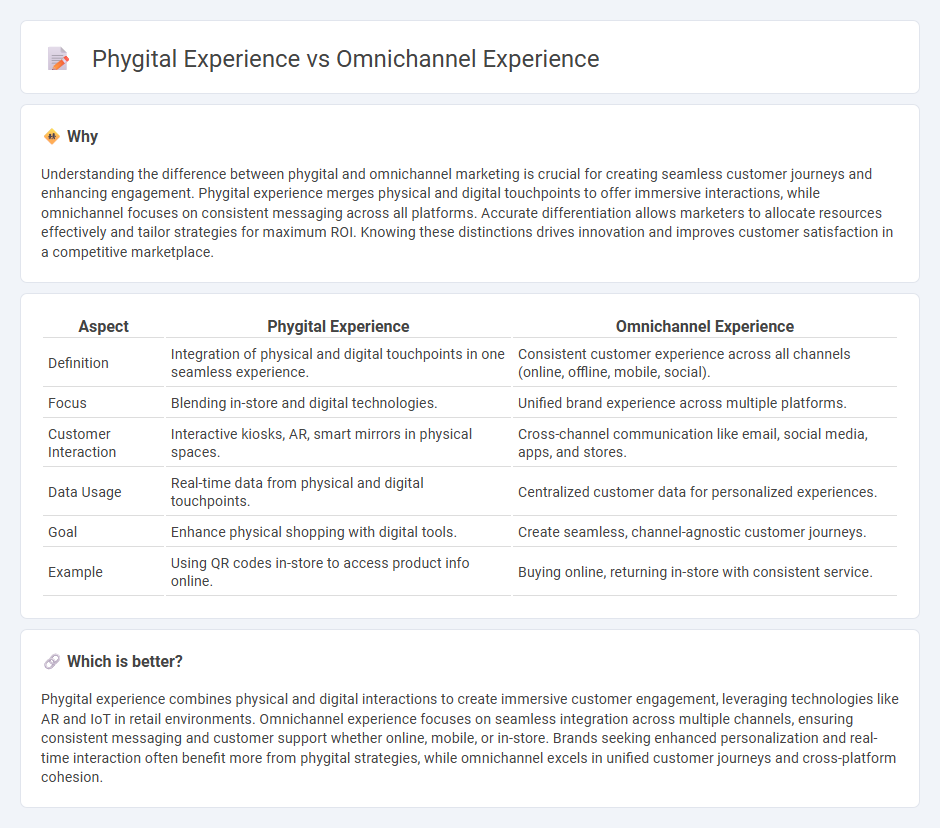
Phygital experience integrates physical and digital touchpoints to create seamless customer interactions, blending real-world engagement with online convenience. Omnichannel experience ensures consistent messaging and service across all channels, enabling customers to switch effortlessly between platforms without losing context. Explore in-depth insights to understand how these strategies transform modern marketing.
Why it is important
Understanding the difference between phygital and omnichannel marketing is crucial for creating seamless customer journeys and enhancing engagement. Phygital experience merges physical and digital touchpoints to offer immersive interactions, while omnichannel focuses on consistent messaging across all platforms. Accurate differentiation allows marketers to allocate resources effectively and tailor strategies for maximum ROI. Knowing these distinctions drives innovation and improves customer satisfaction in a competitive marketplace.
Comparison Table
| Aspect | Phygital Experience | Omnichannel Experience |
|---|---|---|
| Definition | Integration of physical and digital touchpoints in one seamless experience. | Consistent customer experience across all channels (online, offline, mobile, social). |
| Focus | Blending in-store and digital technologies. | Unified brand experience across multiple platforms. |
| Customer Interaction | Interactive kiosks, AR, smart mirrors in physical spaces. | Cross-channel communication like email, social media, apps, and stores. |
| Data Usage | Real-time data from physical and digital touchpoints. | Centralized customer data for personalized experiences. |
| Goal | Enhance physical shopping with digital tools. | Create seamless, channel-agnostic customer journeys. |
| Example | Using QR codes in-store to access product info online. | Buying online, returning in-store with consistent service. |
Which is better?
Phygital experience combines physical and digital interactions to create immersive customer engagement, leveraging technologies like AR and IoT in retail environments. Omnichannel experience focuses on seamless integration across multiple channels, ensuring consistent messaging and customer support whether online, mobile, or in-store. Brands seeking enhanced personalization and real-time interaction often benefit more from phygital strategies, while omnichannel excels in unified customer journeys and cross-platform cohesion.
Connection
Phygital experience merges physical and digital interactions to create seamless customer journeys, enhancing engagement across multiple touchpoints. Omnichannel experience integrates various channels, both online and offline, ensuring consistent messaging and personalized service throughout the customer lifecycle. Together, they maximize brand connectivity and drive higher conversion rates by delivering unified, immersive experiences.
Key Terms
Channel Integration
Omnichannel experience emphasizes seamless channel integration, ensuring customers encounter a consistent and unified brand interaction across digital platforms and physical stores. Phygital experience combines physical and digital touchpoints to create immersive engagements, often leveraging technologies like augmented reality or IoT to blend online convenience with in-store advantages. Explore how advanced channel integration strategies optimize customer journeys in both omnichannel and phygital frameworks.
Customer Journey
Omnichannel experience integrates multiple digital and physical touchpoints, providing customers a seamless journey across channels, while phygital experience blends physical and digital interactions in a single environment to enhance engagement. Both strategies focus on optimizing the customer journey by delivering consistent and personalized experiences, but phygital emphasizes real-time interaction with the environment, such as using AR in-store or contactless payments. Explore how these approaches transform customer behavior and loyalty through innovative journey mapping.
Touchpoints
Omnichannel experience integrates multiple digital and physical touchpoints to provide a seamless customer journey across platforms like websites, mobile apps, social media, and retail stores. Phygital experience combines physical and digital interactions specifically at key physical touchpoints using technologies such as AR kiosks, smart mirrors, and contactless payments to enhance in-store engagement. Explore how optimizing these touchpoints can elevate customer satisfaction and drive sales.
Source and External Links
What is Omnichannel Customer Experience? - Omnichannel customer experience is the seamless and unified interaction a customer has across multiple interconnected channels and touchpoints, ensuring consistent branding, messaging, and personalized engagement regardless of platform or device used.
What Are Omnichannel Experiences? - Omnichannel experiences integrate all customer interaction channels, both online and offline, to create a smooth, singular journey that connects touchpoints like websites, social media, customer service, and in-person visits seamlessly.
What is Omnichannel? 15 Top Omnichannel Experience Examples - Omnichannel is an integrated approach that synchronizes data and channels, such as order and inventory systems, enabling customers to start transactions on one platform and complete them on another for a cohesive experience across devices and locations.
 dowidth.com
dowidth.com